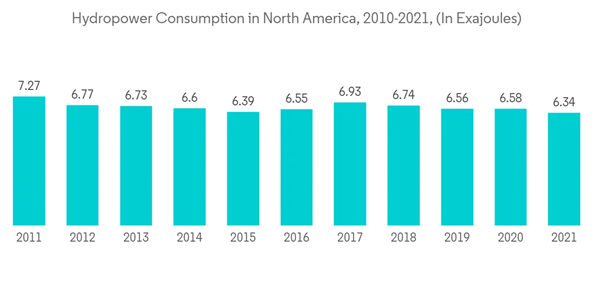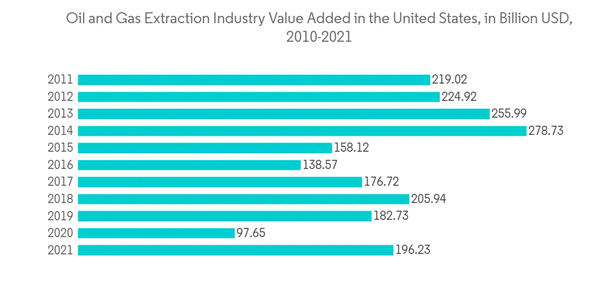The North American industrial valve market is projected to grow at a CAGR of 5.6% during the forecast period. The rising demand for valves in the healthcare and pharmaceutical industries as a result of the COVID-19 pandemic, the growing need for new nuclear power plants and the renovation of existing ones, the increasing need for connected networks to maintain and monitor industrial equipment, the rising adoption of automation technologies in process industries, and the growing global focus on the development of smart cities are the key driving factors for the industrial valve market.
This product will be delivered within 2 business days.
Key Highlights
- The increasing R&D activities in the region about using actuators in valves for automation and the rising demand for safety applications are among the crucial factors driving the market in North America. Research and development at industry levels is broadening the application areas of industrial valves in different industries, such as energy and power, and chemicals, in the United States.
- Furthermore, industrial control valves are widely used in North America's oil and gas, energy and power, and water and wastewater treatment industries to control media flow through a system and start, stop, or throttle the flow, ensuring safe and efficient process automation.
- Additionally, control valves' automation has advanced significantly due to a growing emphasis on precise positioning and automation of industrial valves. A valve positioner converts electrical signals to pneumatic signals to control the valve's actuator in control valves. Thus, automation in the valve positioner provides greater efficiency, lower energy consumption, and increased reliability, which drives the global growth of the industrial valve market.
- The oil and gas industry is the largest global consumer of industrial valves, with industrial valves used in downstream, midstream, and upstream process applications. The heightened demand for industrial valves in North America increases the need for importing industrial valves from other countries, driving the growth of the industrial valve market.
- Moreover, the United States administration raised tariffs on derivative aluminum and steel imports beginning February 8, 2020. This increase includes a 25% increase in steel imports and a 10% increase in aluminum imports, which has harmed the US manufacturing sector. Although the tariff is intended to increase revenue from imports, it negatively impacts global trade in industrial valves.
- Steel is widely used in manufacturing industrial valves, and the steel tariff is expected to impede the market growth. Furthermore, the COVID-19 pandemic has halted the production and sales of various products in the industrial valve industry, owing primarily to the prolonged lockdown in the United States. This has hampered the growth of the industrial valve market in the region.
North America Industrial Valves Market Trends
Increasing Demand from the Power Industry
- Valve applications in the power industry include boiler startup, feed pump recirculation, steam conditioning, and turbine bypass. For instance, the valves in the condensate system control and regulate the extra flow needed for a condensate pump that circulates fluid. In addition, valves are used to regulate the feedwater heater's deaerator level.
- Furthermore, valves are used for boiler feed pump recirculation in the feedwater system in the power industry. In this scenario, the valve is crucial because it needs to be used in modulating and on-off service. The valves are also used in conventional systems for superheaters, turbine bypass, superheater bypass, etc. A modulating valve manages pressure. Such valves generate enormous demand throughout the power industry and will propel market expansion.
- Additionally, the global electricity demand is predicted to increase by 75% by 2030. Although the amount of energy produced by renewable sources is increasing, it is still insufficient to meet the world's expanding electricity demand. Nearly all the utility-scale electricity generated in the United States in 2021 - roughly 96% of the total - was sold to other industries. (Source: US Energy Information Administration)
- Over the coming 25 years, it is expected that more than 2,457 gigawatts (GW) of power capacity will be installed globally, according to the World Energy Outlook-International Energy Agency forecast. The US government's emphasis on boosting capacity additions at power plants across the nation is another factor driving up demand for valves in the power sector.
- According to the EIA, solar and wind energy have seen the biggest increases in electricity generation in the United States. Up from 20% in 2021, it is anticipated that renewable sources will generate 22% of the nation's energy in 2022 and 24% in 2023. Therefore, the need for industrial valves will be most significant for renewable resources in the future, enhancing and boosting the market growth.
- About 778.0 billion kilowatt hours of nuclear energy were produced in 2021. The annual nuclear electricity generation in the United States has been kept at a largely stable level due to increased electric generation capacity upgrades and shorter refueling and maintenance cycles at nuclear power plants. The market will grow due to the growing demand for new nuclear power plants and the renovation of existing ones.
United States will Dominate the Market
- The industrial valve market in North America will remain dominated by American companies. Rising oil and gas activity, rapid urbanization, and adopting automation across key industries are the market drivers for industrial valves in the United States.
- Due to the country's rising energy consumption, oil and gas exploration activities have increased over the past few years. According to the United States Energy Information Administration, the United States has the highest petroleum consumption in the world, with daily consumption in 2021 hovering around 18.7 million barrels. The market for industrial valves is expanding across the United States due to the widespread use of these devices in the drilling, exploration, and refining of oil and gas products.
- However, the nation went into a state of lockdown in the middle of 2020 due to COVID-19 security measures, which caused a significant drop in global oil prices and further curtailed oil and gas-related projects like the storage and transportation of liquid gasses. As a result, businesses that made industrial valves experienced slow growth and revenue losses.
- Additionally, new IoT platforms are being introduced by businesses across the United States to assist industries in remotely monitoring their assets. For instance, in January 2021, Flowserve Corporation, a major supplier of flow control goods and services for the global infrastructure markets, unveiled a ground-breaking IoT service to assist manufacturing facilities in remotely monitoring their assets and significantly lowering equipment failures. Such a service will also detect leaks from valves used in several industries.
- In April 2021, Emerson introduced the ASCO Series 158 Gas Valve and Series 159 Motorized Actuator across the United States. The new burner-boiler-specific products offer OEMs, distributors, contractors, and end-users a new valve option for combustion safety shutoff that improves flow and control while increasing safety and reliability.
- Furthermore, companies throughout the United States are investing in industrial valve companies to help the market grow. For instance, ITT Inc., New York, US, announced in April 2022 that it had acquired privately-held Habonim for USD 140 million in an all-cash transaction. Habonim will join ITT's Industrial Process (IP) division. ITT Inc. will benefit from Habonim's expertise in valves, valve automation, and valve actuation for the gas distribution (including LNG), biotech, and harsh application service industries in the future.
North America Industrial Valves Market Competitor Analysis
North America is highly fragmented, with some of the leading players based out of the region. It is a key market for industrial valves as the region is home to a few of the largest multinational corporations, such as Emerson (US), Cameron-Schlumberger (US), Flowserve Corporation (US), and Crane Co. (US).- May 2022 - Flowserve Corporation was selected to supply control and ball valves to OMV's chemical recycling demonstration plant in Schwechat, Austria. To convert plastic waste into synthetic feedstock, the OMV demonstration plant is expected to use Flowserve's patented ReOiltechnology. The initiative is expected to support Flowserve's goal of assisting customers in driving decarbonization while supporting its growth strategy.
- March 2021 - Emerson introduced a line of two-way and three-way solenoid valves to help original equipment manufacturers develop more compact machines and equipment while maintaining fluid control performance. The new ASCO series 256/356's optimized body design and internal flow path provide a smaller footprint, lower power consumption, and higher pressure ratings, which are critical in industrial and commercial applications.
Additional benefits of purchasing the report:
- The market estimate (ME) sheet in Excel format
- 3 months of analyst support
This product will be delivered within 2 business days.
Table of Contents
1 INTRODUCTION
4 MARKET INSIGHTS
5 MARKET DYNAMICS
6 MARKET SEGMENTATION
7 COMPETITIVE LANDSCAPE
Companies Mentioned (Partial List)
A selection of companies mentioned in this report includes, but is not limited to:
- Emerson Electric Co.
- Flowserve Corporation
- Baker Hughes
- Schlumberger Limited
- Eaton Corporation
- Crane HoldingS Co.
- Mueller Water Products Inc.
- KITZ Corporation
- ITT Inc.
- The Weir Group PLC
- ALFA LAVAL AB
- Apollo Valves
- Bray International
- CIRCOR International Inc.
- Trillium Flow Technologies
Methodology

LOADING...










